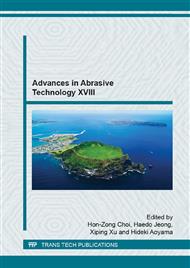[1]
J. B. Casady and R. W. Johnson, Status of silicon carbide (SiC) as a wide-bandgap semiconductor for high-temperature applications: A review, Solid. State. Electron., 39, 96, (1996) 1409–1422.
DOI: 10.1016/0038-1101(96)00045-7
Google Scholar
[2]
S. Goel, X. Luo, P. Comley, R. L. Reuben, and A. Cox, Brittle–ductile transition during diamond turning of single crystal silicon carbide, Int. J. Mach. Tools Manuf., 65, (2013) 15-21.
DOI: 10.1016/j.ijmachtools.2012.09.001
Google Scholar
[3]
Y. B. Gerbig, C. a. Michaels, a. M. Forster, and R. F. Cook, In situ observation of the indentation-induced phase transformation of silicon thin films, Phys. Rev. B, 85, 10, (2012) 104102.
DOI: 10.1103/physrevb.85.104102
Google Scholar
[4]
C. -Y. Yen, S. -R. Jian, Y. -S. Lai, P. -F. Yang, Y. -Y. Liao, J. S. -C. Jang, T. -H. Lin, and J. -Y. Juang, Mechanical properties of the hexagonal HoMnO3 thin films by nanoindentation, J. Alloys Compd., 508, 2, (2010) 523-527.
DOI: 10.1016/j.jallcom.2010.08.109
Google Scholar
[5]
J. Yan, X. Gai, and H. Harada, Subsurface Damage of Single Crystalline Silicon Carbide in Nanoindentation Tests, J. Nanosci. Nanotechnol., 10, 11, (2010) 7808-7811.
DOI: 10.1166/jnn.2010.2895
Google Scholar
[6]
W. C. Oliver and G. M. Pharr, An improved technique for determining hardness and elastic modulus using load and displacement sensing indentation experiments, J. Mater. Res., 7, 6, (1992) 1564-1583.
DOI: 10.1557/jmr.1992.1564
Google Scholar
[7]
J. Yan, H. Takahashi, J. Tamaki, X. Gai, H. Harada, and J. Patten, Nanoindentation tests on diamond-machined silicon wafers, Appl. Phys. Lett., 86, 18, (2005) 181913.
DOI: 10.1063/1.1924895
Google Scholar
[8]
S. Nakashima and H. Harima, Raman investigation of SiC polytypes, Phys. Stat. Sol. (a), 162, 39, (1997) 39-64.
DOI: 10.1002/1521-396x(199707)162:1<39::aid-pssa39>3.0.co;2-l
Google Scholar
[9]
J. Jang, M. J. Lance, S. Wen, T. Y. Tsui, and G. M. Pharr, Indentation-induced phase transformations in silicon: influences of load, rate and indenter angle on the transformation behavior, Acta Mater., 53, 6, (2005) 1759–1770.
DOI: 10.1016/j.actamat.2004.12.025
Google Scholar
[10]
T. Kiriyama, H. Harada, and J. Yan, Finite element modeling of high-pressure deformation and phase transformation of silicon beneath a sharp indenter, Semicond. Sci. Technol., 24, (2009) 025014.
DOI: 10.1088/0268-1242/24/2/025014
Google Scholar


